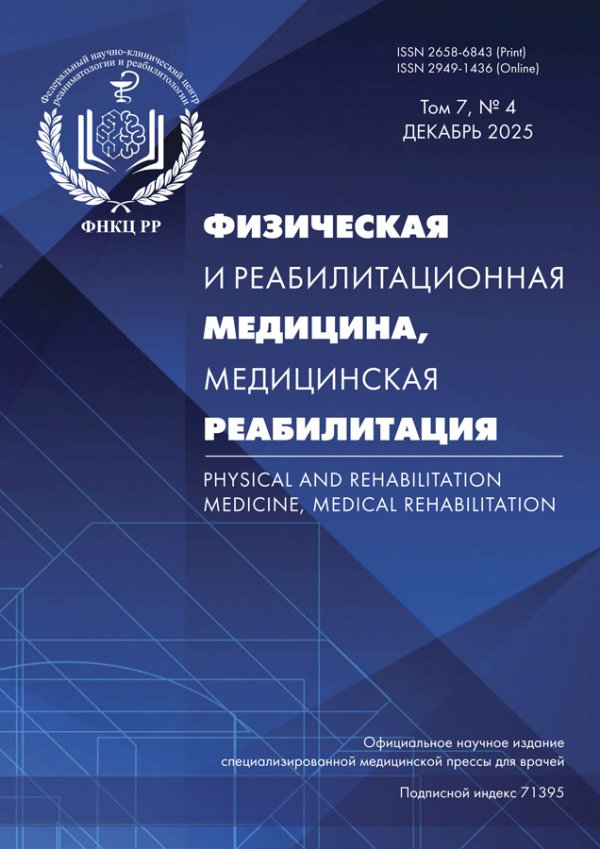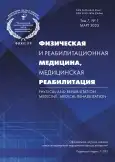Locomotor therapy in unweighted conditions in patients with chronic disorders of consciousness. A prospective non-randomized single-center study
- Authors: Nagaev N.S.1, Belkin V.A.1, Belkin A.A.1,2, Rudnik E.N.1,2, Zhiguzhevsky R.A.1, Rakhmatullin I.F.3, Roznin A.V.1
-
Affiliations:
- Clinical Institute of the Brain
- Ural State Medical University
- LLC «Krisaf»
- Issue: Vol 7, No 1 (2025)
- Pages: 13-23
- Section: ORIGINAL STUDY ARTICLE
- URL: https://journals.rcsi.science/2658-6843/article/view/288224
- DOI: https://doi.org/10.36425/rehab649890
- ID: 288224
Cite item
Full Text
Abstract
BACKGROUND: It is known that regular physical activity stimulates synaptic plasticity in the central nervous system. Neurons involved in movement and sensory integration form new connections, contributing to the restoration of lost functions (angiogenesis, neurogenesis, changes in cortical pathways). Based on this, it was hypothesized that KRISAF device (locomotor therapy in unweighted conditions) in patients with chronic disorders of consciousness, due to the presence of passive stereotyped motor cycles mimicking crawling/swimming/walking, may modulate the recovery of cerebral hemisphere functions and subsequently affect the level of consciousness through the mechanism of afferent ontogenetic “recollection.”
AIM: To assess the changes in cerebral hemisphere function recovery based on the scores of the CRS-R, Behavioral Pain Scale, Ashworth Scale, and Glasgow Outcome Scale Extended (GOS-E) in patients with chronic disorders of consciousness undergoing locomotor therapy in unweighted conditions.
MATERIALS AND METHODS: A descriptive prospective comparative cohort study included 74 patients from 2019 to 2024. They were divided into two groups: intervention group (n=44) and control group (n=30). Patients in the intervention group, in addition to the main course of rehabilitation treatment, received 5 sessions of locomotor therapy in unweighted conditions.
RESULTS: The median level of consciousness score according to the CRS-R scale in the intervention group increased from 6 (5.4–6.6) to 9 (8.1–9.9) points (p=0.0006), while in the control group, it increased from 5.5 (4.7–6.3) to 7 (6–8) points (p=0.0609), indicating a statistically significant difference (p <0.00001).
CONCLUSION: The significant improvement in the CRS-R score at discharge among patients undergoing locomotor therapy indicates that this treatment method has a positive effect on the level of consciousness.
Full Text
##article.viewOnOriginalSite##About the authors
Nikita S. Nagaev
Clinical Institute of the Brain
Email: nagaevns@yandex.ru
ORCID iD: 0009-0007-0561-4879
SPIN-code: 9610-4678
Russian Federation, Berezovsky
Vladimir A. Belkin
Clinical Institute of the Brain
Email: vbelkin@neuro-clinic.ru
ORCID iD: 0000-0002-4043-743X
SPIN-code: 4402-0608
Russian Federation, Berezovsky
Andrey A. Belkin
Clinical Institute of the Brain; Ural State Medical University
Author for correspondence.
Email: belkin@neuro-ural.ru
ORCID iD: 0000-0002-0544-1492
SPIN-code: 6683-4704
MD, Dr. Sci. (Medicine), Professor
Russian Federation, Berezovsky; EkaterinburgEvgeniy N. Rudnik
Clinical Institute of the Brain; Ural State Medical University
Email: erudnik@mail.ru
ORCID iD: 0000-0001-9979-1276
Russian Federation, Berezovsky; Ekaterinburg
Roman A. Zhiguzhevsky
Clinical Institute of the Brain
Email: zhiguzhevskiyra@mail.ru
ORCID iD: 0000-0001-6673-8866
Russian Federation, Berezovsky
Ildar F. Rakhmatullin
LLC «Krisaf»
Email: rif@krisaf.com
ORCID iD: 0009-0003-5845-6385
Russian Federation
Andrey V. Roznin
Clinical Institute of the Brain
Email: roznin.andrei@yandex.ru
ORCID iD: 0009-0003-9950-4494
Russian Federation, Berezovsky
References
- Wan X, Zhang Ye, Li Ya, Song W. An update on noninvasive neuromodulation in the treatment of patients with prolonged disorders of consciousness. CNS Neurosci Ther. 2024;30(5):e14757. doi: 10.1111/cns.14757 EDN: QVKTGV
- Cooper JB, Jane JA, Alves WM, Cooper EB. Right median nerve electrical stimulation to hasten awakening from coma. Brain Inj. 1999;13(4):261–267. doi: 10.1080/026990599121638
- Peri CV, Shaffrey ME, Farace E, et al. Pilot study of electrical stimulation on median nerve in comatose severe brain injured patients: 3 month outcome. Brain Inj. 2001;15(10):903–910. doi: 10.1080/02699050110065709
- Wu X, Zhang C, Feng J, et al. Right median nerve electrical stimulation for acute traumatic coma (the Asia Coma Electrical Stimulation trial): Study protocol for a randomised controlled trial. Trials. 2017;18(1):311. doi: 10.1186/s13063-017-2045-x
- Noé E, Ferri J, Colomer C, et al. Feasibility, safety and efficacy of transauricular vagus nerve stimulation in a cohort of patients with disorders of consciousness. Brain Stimul. 2020;13(2):427–429. doi: 10.1016/j.brs.2019.12.005 EDN: OQELSD
- Marino MH. Pharmacology in treatment of patients with disorders of consciousness. Phys Med Rehabil Clin N Am. 2024;35(1):155–165. doi: 10.1016/j.pmr.2023.06.023 EDN: CAJLMD
- Thibaut A, Wannez S, Deltombe T, et al. Physical therapy in patients with disorders of consciousness: Impact on spasticity and muscle contracture. NeuroRehabilitation. 2018;42(2):199–205. doi: 10.3233/NRE-172229
- Nudo RJ. Neural bases of recovery after brain injury. J Commun Disord. 2011;44(5):515–520. doi: 10.1016/j.jcomdis.2011.04.004
- Esquenazi A, Lee S, Wikoff A, et al. A comparison of locomotor therapy interventions: Partial-body weight-supported treadmill, Lokomat, and G-EO training in people with traumatic brain injury. PM R. 2017;9(9):839–846. doi: 10.1016/j.pmrj.2016.12.010
- Williams K, Christenbury J, Niemeier JP, et al. Is robotic gait training feasible in adults with disorders of consciousness? J Head Trauma Rehabil. 2020;35(3):E266–E270. doi: 10.1097/HTR.0000000000000523 EDN: DMNAZK
- Esquenazi A, Lee S, Packel AT, Braitman L. A randomized comparative study of manually assisted versus robotic-assisted body weight supported treadmill training in persons with a traumatic brain injury. PM R. 2013;5(4):280–290. doi: 10.1016/j.pmrj.2012.10.009
- Hofstoetter US, Krenn M, Danner SM, et al. Augmentation of voluntary locomotor activity by transcutaneous spinal cord stimulation in motor-incomplete spinal cord-injured individuals. Artif Organs. 2015;39(10):E176–E186. doi: 10.1111/aor.12615 EDN: VGDFIL
- Belkaniya GS, Dilenyan LR, Bagriy AS, et al. «Gravitational biology--anthropology» in jistification of anthropogenic bases of health and illness. Modern problems of science and education. 2014;(4):280. EDN: STROTH
- Bebenina IP. Neurological status of human foetus in labour and its analysis in evolutionary aspect. S.S. Korsakov journal of neurology and psychiatry. 1983;83(12):1800–1804. (In Russ.)
Supplementary files














